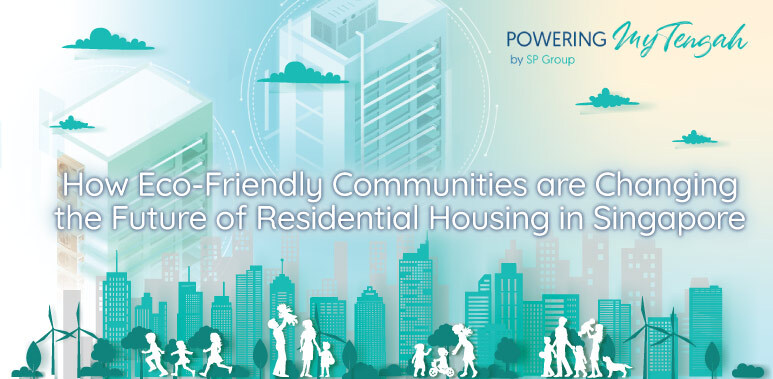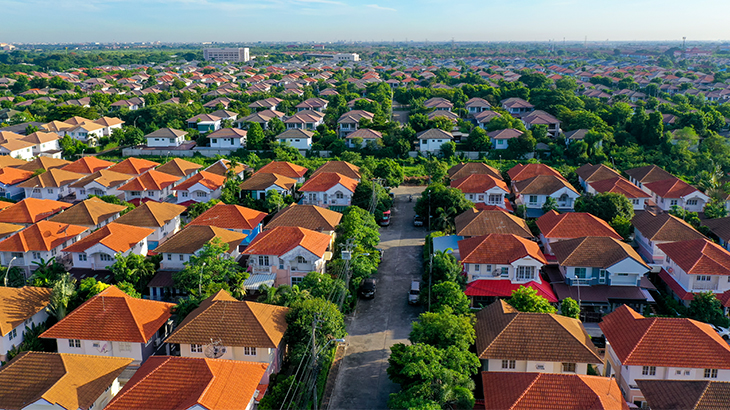How Eco-Friendly Communities is Changing the Future of Residential Housing in Singapore

Written by Cynthia Wong, Vice President, (Commercial & Marketing) Sustainable Energy Solutions at SP Group
Sustainability has indeed been of recent a well debated topic.
Greening Singapore and mitigating climate change – is that not a responsibility of our Singapore government, to provide shade and green spaces for all Singaporeans to enjoy?
Interestingly, Singapore has seen a surge in green efforts and advocacy at the individual level in recent years. Green movements initiated by youths, such as the anti-straw movement which saw young people saying no to straws at food eateries and many switching to reusable metal straws has become a trend.
While these efforts have contributed greatly to increase environmental awareness in Singaporeans, the actual environmental impact is not so clear… which brings us to the question: how is Singapore faring as a country? And who is responsible to make it all happen?
Reports show that Singapore generated 52 million tonnes of greenhouse gases in 2017, which accounts for an overwhelming 0.12% of global greenhouse gas emissions. When energy is generated, greenhouse gases are released–part of this generated energy goes towards supporting our households. This means Singapore’s households use energy that contributes to a huge portion of greenhouse gases in the world!
That begets a new question: Singapore is not faring as well as a country, in terms of its carbon footprint. We still have a long way to go and we should be concerned, bearing in mind that greenhouse gases contribute to the greenhouse effect, warming our planet and making Singapore vulnerable to extreme weather changes and rising sea levels.
The recent recollection of recent working from home, experiencing days where the temperatures and humidity has mercilessly hovered to a sweltering 33 degrees… I shudder to imagine a Singapore that is warmer than it already is today.
The good news is that the Singapore government has followed through with several initiatives like reducing Emissions Intensity (or emissions rate) by 36% from 2005 with aim for emissions to be most stable by 2030. An example of one such initiative that has kicked off is the beginning transformation of Singapore’s housing estates into eco-towns.

What is an eco-town?
If you’ve never heard the term before, an eco-town is a town designed to be more environmentally sustainable and liveable. Whether you are a resident, a small business operator, a town council operator or just a passer-by, an eco-town promotes energy efficiency, and environmentally sustainable habits as a leading mindset.
Tengah will be an exemplary showcase of what and how Singapore’s eco-towns will be. With an area of about 7km 2, Tengah is approximately the size of Bishan and houses about 42,000 homes within five different residential districts–out of which 70% of these homes are public housing, or HDBs.
Features of Singapore’s first eco-town
A key feature of Tengah is its centralised cooling system (CCS). Tengah will introduce modular chiller plants located at selected block rooftops that directly provides alternative air-conditioning cooling using chilled water,
Simply put, imagine you can do away with your outdoor condenser units that sits on the AC edge from your AC inverter unit. Instead, your house will now have an air-conditioning system powered by highly efficient, commercial grade chiller plants.
Instead of refrigerant, which has corresponding global warming and ozone depletion risks in usage, CCS delivers chilled water direct to the indoor cooling units to your home .
Not only is CCS more environment friendly, it is also more energy efficient
The chilled water takes the heat from each home and rejects it to the atmosphere at the cooling towers, where this is efficiently done. In contrast, conventional AC systems like spilt units uses outdoor air for the ‘heat exchange”, requiring the raising of the refrigerant temperature to be raised above the ambient before it can ‘reject’ the room heat”. So, on those hot sweltering 33 degrees days, I have to ‘full blast up” to turn up my air-conditioning (longer time too) to get to the desired cooling relief.
Additionally, the centralised chiller plants are designed with the cooling capacity to support an entire cluster of housing blocks, versus being limited to the capacity of an outdoor condenser unit attached to my individual home. I can rest easy that the CCS system will provide a much higher level of uninterrupted quality of cooling service which a conventional spilt unit system cannot provide. Imagine staying in an HDB housing estate equipped with the same centralised cooling system that powers buildings in Marina Bay Sands today! Undoubtedly, savvy property agents will have a field day marketing this to potential home buyers in Tengah
When fully implemented in Tengah, CCS will save up to 30Gwh of energy a year, which is equivalent to removing 12.6 million kg of carbon dioxide from the air or powering an additional 7,000 4-room HDB flats annually.
Another unique facet of Tengah is its utilisation of alternative and renewable energy sources to power households. In general, Singapore relies on natural gas to generate electricity. Limited land resources make it difficult for Singapore to use alternative clean energy sources like solar farms. Tengah introduces clean energy sources by installing solar panels across three of its districts, generating about 6Gwh of renewable energy a year, used to partially power the residential cooling system.
Not forgetting the Digital Eco Boards that will be installed at the Tengah blocks, this will enable residents to get not only timely updates of their block’s energy consumption and carbon emissions, but their total electricity and water usage. It will also be used to offer green tips and advice for residents to lower their utilities consumption, and to facilitate energy-saving challenges such as block-level competitions. This will enable residents to be more conscious of their impact on the environment and take individual steps to lower their consumption and carbon emissions. This is just an important feature as any other energy-saving smart facilities because the town relies on the educated choices of each and every individual living in it.
Today, Tengah homeowners have the voluntary choice to opt-in for centralised cooling for their homes. If, however, everyone makes the sustainable choice, the energy-saving impact of the centralised cooling system will make a stronger impact on Singapore, and the world.
An eco-town will not work without the green choices and actions taken by its residents. Energy-saving results of a centralised cooling system will only work when also paired with the continued green decisions and mindset of the community.
So, is greening and building a sustainable Singapore for our future the responsibility of our government to lead?
I believe every individual plays an important role, whether it is in Tengah, or the whole of Singapore, building our sustainable future begins with each of us. It may not seem significant for a single person to create the impact but multiply the effort by the number of people in a household, then 22,000 homes in Tengah, hopefully, in many future HDB estates we will get a ripple with a significant difference.
Disclaimer:
The views and opinions expressed in this article are those of the authors and do not necessarily reflect the official policy or position of any agency or organisation.
Aug 26 2020
CATEGORIES
FEATURED POST

Sustainability and Climate Change – A Global Approach
There are no posts!
| Mon | Tue | Wed | Thu | Fri | Sat | Sun |
|---|---|---|---|---|---|---|
|
28
|
29
|
30
|
1
|
2
|
3
|
4
|
|
5
|
6
|
7
|
8
|
9
|
10
|
11
|
|
12
|
13
|
14
|
15
|
16
|
17
|
18
|
|
19
|
20
|
21
|
22
|
23
|
24
|
25
|
|
26
|
27
|
28
|
29
|
30
|
31
|
1
|
